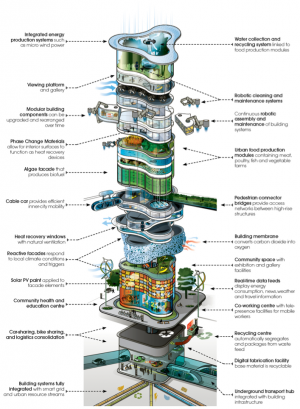Envisioning the urban skyscraper of 2050
Ars Technica » Scientific Method 2013-02-18

The urban buildings of the near-future will be tall, smart, adaptable, responsive, honest, modular, recyclable, clean, and deeply embedded into the systems of their host cities, if an imaginative vision from Arup's Foresight team is anything to judge by. In its evocatively titled It's Alive, Arup (the firm responsible for the structural design of the iconic Sydney Opera House) asks if we can imagine the urban building of the future while simultaneously presenting its take on the matter. The report contains plenty of ideas, albeit briefly stated, so I thought it would be fun to identify some of today's science and technology that has made it into Arup's skyscraper of tomorrow and discuss whether Arup's vision is more grounded in fact or fiction.
It was the best of times, it was the worst of times
Arup's future-scraper is the product of its time; a time 37 years from now that will suck and be awesome in approximately equal measures. Why suck? Because 37 years will see us through to the year 2050, and Arup shares (or perhaps borrows) the OECD's troubling forecast of a warming, overpopulated Earth hungry for, yet deficient in, essential resources. According to this narrative, there will be 9 billion people, with 6.3 billion living in towns and cities.
The good news is that we'll still have iPhones—or their future-proxies, at least. Arup describes the denizens of our future cities as "net-native adults" who have grown up with smart cities, smart clothes, and smart objects. The Internet of Things will be ubiquitous, Arup suggests; presumably to the point that it has been abbreviated simply to "things," the "Internet of" having been long since forgotten.
Read 25 remaining paragraphs | Comments
